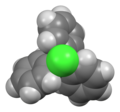 | |||
| |||
| Names | |||
|---|---|---|---|
| Preferred IUPAC name 1,1′,1′′-(Chloromethanetriyl)tribenzene | |||
| Other names (Chloromethanetriyl)tribenzene [Chloro(diphenyl)methyl]benzene | |||
| Identifiers | |||
3D model (JSmol) | |||
| ChemSpider | |||
| ECHA InfoCard | 100.000.898 | ||
PubChem CID | |||
| UNII | |||
CompTox Dashboard (EPA) | |||
| |||
| |||
| Properties | |||
| C19H15Cl | |||
| Molar mass | 278.7754 g/mol | ||
| Appearance | white to yellow solid | ||
| Density | 1.141 g/cm3 | ||
| Melting point | 109 to 112 °C (228 to 234 °F; 382 to 385 K) | ||
| Boiling point | 230 °C (446 °F; 503 K) (at 20 mmHg) and 374.3 °C (at 760 mmHg) | ||
| Solubility | soluble in chloroform, benzene, acetone, [1] ether, THF, hexane [2] | ||
| Hazards | |||
| Flash point | 177.9 °C (352.2 °F; 451.0 K) | ||
| Safety data sheet (SDS) | Corvine Chemicals MSDS | ||
Except where otherwise noted, data are given for materials in their standard state (at 25 °C [77 °F], 100 kPa). | |||
Triphenylmethyl chloride or trityl chloride (TrCl) is a white solid with the chemical formula C19H15Cl. It is an alkyl halide, sometimes used to introduce the trityl protecting group.

